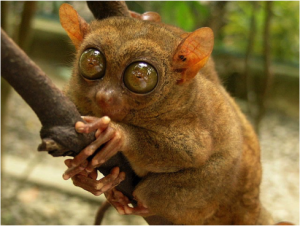Take your hands and put your fingertips to your thumb tips to make two O’s. Put the O’s up to your eyes and now you have your very own pretend binoculars.
Binoculars are a special tool that magnify things that are far away. They make objects look closer and bigger. Many people use binoculars to look at birds and wildlife so they can see them in detail without getting too close.
There are some animals that have amazing eyesight without using a tool like binoculars. So grab your binoculars and let’s explore so that we can learn more about these incredible animals.
Dragonfly
 Let’s use your binoculars to look near a lake! Do you see the creature with the long skinny body and can flit and dart all around with its wings? It’s a dragonfly!
Let’s use your binoculars to look near a lake! Do you see the creature with the long skinny body and can flit and dart all around with its wings? It’s a dragonfly!
A dragonfly is an amazing hunter that lives near water. One feature that helps them have such incredible hunting skills are their eyes. Dragonflies’ eyes take up almost their entire head. This lets them see almost all the way around them without even moving their head.
Dragonflies have compound eyes, like many other insects. This means they have many different facets covering their eyes that creates a sort of mosaic or pieced together picture. They are very sensitive to movement and can see more colors than humans can.
The best part of the dragonfly eye is that it helps them hunt mosquitos! Some dragonflies can eat up to a hundred pesky mosquitos in a day!
Four Eyed Fish
Let’s look under the water in South America for a fish with extra special eyes. The four eyed fish does not truly have four eyes, but it kind of looks like it. This fish only has two eyes, but each eye is divided in half. This lets the fish look above and below water at the same time.
The fish drifts near the top of the water and can look underneath and along the surface of the water to watch for both food and danger. The top half of the eye can’t see very well underwater, but the four eyed fish dives under only once in awhile to make sure the top half doesn’t dry out.
Now use your binoculars to look up in a tree. Tarsiers are jungle animals, living on islands in Southeast Asia. They are nocturnal so you will have to look for them at night, that is when they are active.
To be able to see well at night, tarsiers have adapted enormous eyes. They have the largest eyes relative to their body size of any mammal. Their eyes are heavier than their brains!
They can also move their heads 180 degrees in each direction. Tarsiers can see behind them without turning their bodies around.
Tarsiers’ enormous eyes help them sense movement and allow them to find prey, which is the animals they catch for food and alert them of dangerous predators, animals that may eat them as food.
Goats
You don’t need binoculars to see this creature, you can get up close to it at a farm or a petting zoo. Goats may seem like ordinary creatures, but they have extraordinary eyes. Human eyes have round pupils, the black part in the middle, but goats have pupils that are rectangular.
Rectangular eyes allow goats to see almost all the way around them. This helps them to watch for predators while they are grazing. A rectangular eye also means a goat can’t see very well above or below them. A goat must move its whole head to look up or down.
Chameleon
This creature can be hard to spot, even with binoculars. The chameleon is a small lizard that usually lives in trees. It can change its color to match its surroundings, making it very difficult to see. Chameleons have another trick.
There eyes can move separately from one another. One eye can look in one direction, while another eye looks in different direction. A chameleon’s brain can process two pictures at the same time, but scientists still aren’t quite sure how they do it!
Amazing Eyes
Eyes are amazing and they help creatures look for food and avoid danger. These creatures have adapted unique eyes that help them survive and hunt in their special habitats. Now you can take your pretend binoculars outside and use your special eyes to look for more amazing creatures! Sing along with Jungle Jim to learn more fun animal facts.
Sources
“10 Animals with Incredible Eyes” Listverse
“14 Fun Facts about Dragonflies” Smithsonian
“I Spy” Museum of Life and Science

